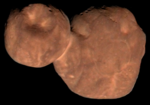astro.wikisort.org - Meteorite
Proxima Centauri c (also called Proxima c[2] or Alpha Centauri Cc) is a controversial[4] exoplanet candidate claimed to be orbiting the red dwarf star Proxima Centauri, which is the closest star to the Sun and part of a triple star system. It is located approximately 4.2 light-years (1.3 parsecs; 40 trillion kilometres; 25 trillion miles) from Earth in the constellation of Centaurus, making it, Proxima b, and Proxima d the closest known exoplanets to the Solar System.
 Schematic: Orbits of Proxima Centauri b and Proxima Centauri c around Proxima Centauri | |
| Discovery[1] | |
|---|---|
| Discovered by | Damasso et al. |
| Discovery site | HARPS |
| Discovery date | January 2020 |
Detection method | Radial velocity |
| Orbital characteristics | |
Semi-major axis | 1.489±0.049 AU[2] |
| Eccentricity | 0.04±0.01[3] |
Orbital period (sidereal) | 1928±20 d[3] |
| Inclination | 133±1[3] |
Longitude of ascending node | 331±1[3] |
Longitude of periastron | −4±4[3] |
Time of periastron | 2456202±21[3] |
| Semi-amplitude | 1.1±0.2[3] |
| Star | Proxima Centauri |
| Physical characteristics | |
| Mass | 7±1 MEarth[3] |
| Temperature | 39 K (−234.2 °C; −389.5 °F)[1] |
Proxima Centauri c is a super-Earth or mini-Neptune about 7 times as massive as Earth, orbiting at roughly 1.49 AU (223 million km; 139 million mi) every 1,928 days (5.28 yr).[3] Due to its large mass and its distance from Proxima Centauri, the exoplanet is uninhabitable, with an equilibrium temperature of approximately 39 K (−234.2 °C; −389.5 °F).[1] The planet is not transiting its parent star from the point of view of an Earth-based observer.[5]
The planet was first reported by Italian astrophysicist Mario Damasso and his colleagues in April 2019. Damasso's team had noticed minor movements of Proxima Centauri in the radial velocity data from the ESO's HARPS instrument, indicating a possible second planet orbiting Proxima Centauri.[6] The discovery was published in January 2020.[1] In June 2020, the planet's existence was initially confirmed using Hubble astrometry data from c. 1995, allowing its inclination and true mass to be determined.[3][7] Also in June 2020, a possible directly imaged counterpart of Proxima c was detected in the infrared with SPHERE, but the authors admit that they "did not obtain a clear detection".[8] If their candidate source is in fact Proxima Centauri c, it is too bright for a planet of its mass and age, implying that the planet may have a ring system with a radius of around 5 RJ.[8]
However, a 2022 study questioned the planetary nature of the observed radial velocity signal corresponding to Proxima c, attributing it to systematic effects.[4] If this is the case, it is unclear why astrometric observations detected what appeared to be a similar planetary signature.
See also
References
- Damasso, Mario; et al. (January 2020). "A low-mass planet candidate orbiting Proxima Centauri at a distance of 1.5 AU". Science Advances. 6 (3): eaax7467. Bibcode:2020SciA....6.7467D. doi:10.1126/sciadv.aax7467. PMC 6962037. PMID 31998838.
- Kervella, Pierre; Arenou, Frédéric; Schneider, Jean (March 2020). "Orbital inclination and mass of the exoplanet candidate Proxima c". Astronomy & Astrophysics. 635: L14. arXiv:2003.13106. Bibcode:2020A&A...635L..14K. doi:10.1051/0004-6361/202037551. S2CID 214713486.
- Benedict, G. Fritz; McArthur, Barbara E. (June 2020). "A Moving Target—Revising the Mass of Proxima Centauri c". Research Notes of the AAS. 4 (6): 86. Bibcode:2020RNAAS...4...86B. doi:10.3847/2515-5172/ab9ca9. S2CID 225798015. Retrieved 23 July 2020.
- Artigau, Étienne; Cadieux, Charles; Cook, Neil J.; Doyon, René; Vandal, Thomas; et al. (June 23, 2022). "Line-by-line velocity measurements, an outlier-resistant method for precision velocimetry". The Astronomical Journal (published August 8, 2022). 164:84 (3): 18pp. arXiv:2207.13524. Bibcode:2022AJ....164...84A. doi:10.3847/1538-3881/ac7ce6.
- Gilbert, Emily A.; Barclay, Thomas; Kruse, Ethan; Quintana, Elisa V.; Walkowicz, Lucianne M. (2021), "No Transits of Proxima Centauri Planets in High-Cadence TESS Data", Frontiers in Astronomy and Space Sciences, 8: 190, arXiv:2110.10702, Bibcode:2021FrASS...8..190G, doi:10.3389/fspas.2021.769371
- Billings, Lee (April 12, 2019). "A Second Planet May Orbit Earth's Nearest Neighboring Star". Scientific American. Retrieved April 12, 2019.
- Benedict, Fritz (June 2, 2020). "Texas astronomer uses 25 year-old Hubble data to confirm planet Proxima Centauri c". McDonald Observatory. University of Texas.
- Gratton, R.; et al. (June 2020). "Searching for the near-infrared counterpart of Proxima c using multi-epoch high-contrast SPHERE data at VLT". Astronomy & Astrophysics. 638: A120. arXiv:2004.06685. Bibcode:2020A&A...638A.120G. doi:10.1051/0004-6361/202037594. S2CID 215754278.
На других языках
[de] Proxima Centauri c
Proxima Centauri c (auch Proxima c[1] oder Alpha Centauri Cc genannt) ist ein Exoplanet, der von Fritz Benedict und Barbara E. McArthur in ihrem Forschungsbericht 2019 (ohne Peer-Review) vorgestellt wurde,[2] woraufhin ein Eintrag in die Extrasolar Planets Encyclopaedia (EPE) erfolgte.[5][6]- [en] Proxima Centauri c
[ru] Проксима Центавра c
Проксима Центавра c (также Проксима c или Альфа Центавра C c[2]) — неподтверждённая (но при этом неоспоримая[note 1]) экзопланета в системе Проксимы Центавра, ближайшей к Солнцу звезды. Находится в созвездии Центавра на расстоянии 4,2 световых лет от Солнца, что делает эту экзопланету ближайшей из известных к Земле (поочерёдно с Проксимой Центавра b).Другой контент может иметь иную лицензию. Перед использованием материалов сайта WikiSort.org внимательно изучите правила лицензирования конкретных элементов наполнения сайта.
WikiSort.org - проект по пересортировке и дополнению контента Википедии



